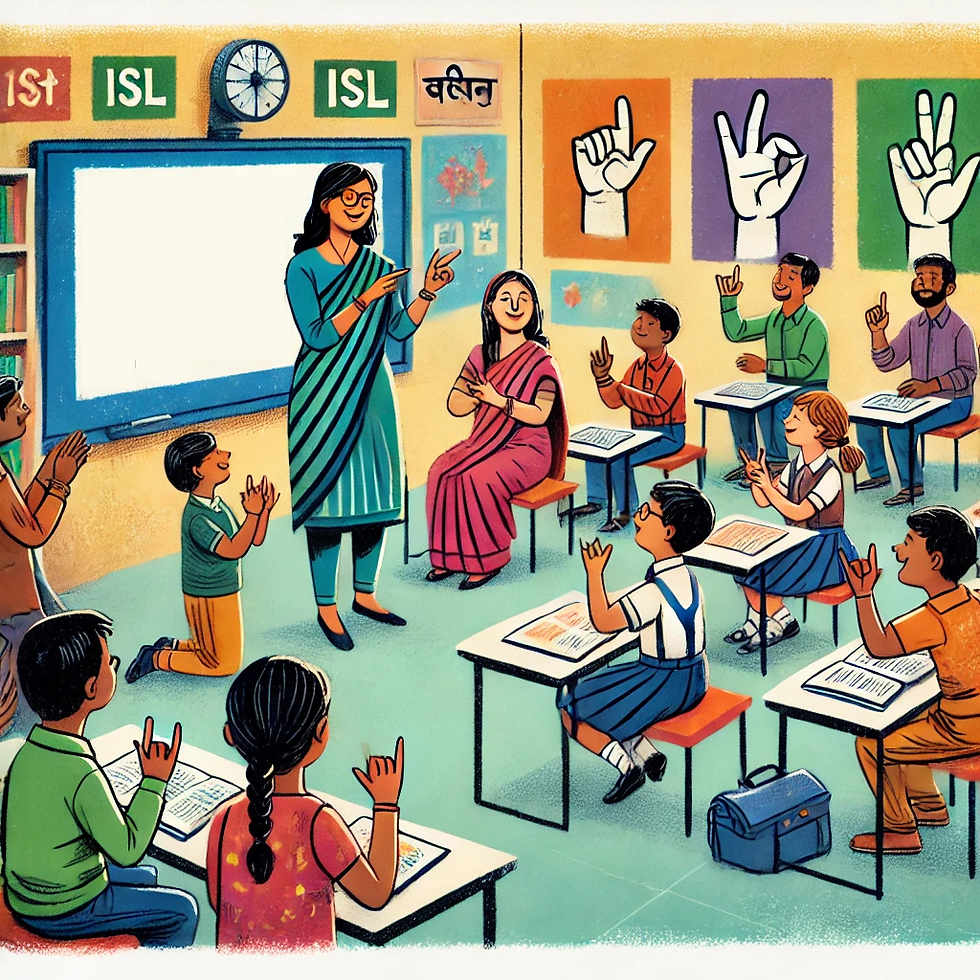Understanding Sign Language and Its Role in Inclusive Communication
- idam the space
- Jan 28
- 3 min read

Sign language is a visual means of communication that uses gestures, facial expressions, and body movements to convey meaning. It’s a language born out of necessity and shaped by culture, providing millions of people worldwide, particularly those with hearing disabilities, with an invaluable tool for self-expression and connection.
In this blog, we’ll take you through the history of sign language, its transformative role in fostering inclusivity, and how Indian Sign Language (ISL) empowers individuals in India. We’ll also look at the benefits of learning sign language and how it can pave the way for a more inclusive society.
What is Sign Language?
Sign language is a complete and natural language that uses visual-manual modality to convey meaning. Unlike spoken languages, which rely on sound, sign language is based on the movements of the hands, face, and body. While sign languages vary across regions and cultures, they all serve the same purpose: to ensure that communication is accessible to all.
A Brief History of Sign Language
The roots of sign language trace back to ancient civilizations where Deaf individuals used hand gestures to communicate. Modern sign languages began to take shape in the 18th century, with the establishment of schools for the Deaf in Europe. American Sign Language (ASL) emerged in the early 19th century, influenced by French Sign Language (LSF). Indian Sign Language (ISL), although formalized much later, has a rich and evolving history that continues to empower millions in the Indian subcontinent.
Indian Sign Language (ISL): A Gateway to Inclusion
Indian Sign Language, or ISL, is used a common means of communication by the Deaf community. According to WHO, in India there are approximately 63 million people, who are suffering from Significant Auditory Impairment, and ISL serves as a crucial communication bridge. Its unique combination of hand shapes, movements, and facial expressions allows Deaf individuals to interact, access education, and thrive in professional environments.
The Significance of Sign Language
Breaking Communication Barriers:
ISL ensures that individuals who rely on sign language are not excluded from conversations, whether in personal, educational, or professional settings.
Empowering Communities:
Sign language equips Deaf individuals with the tools to access opportunities in education, healthcare, and employment, fostering independence and confidence.
Promoting Inclusivity and Equality:
By incorporating ISL into schools, workplaces, and public spaces, society takes a significant step toward creating an environment where everyone feels valued and included.
Why Introduce Sign Language Early?
Teaching sign language in early childhood education has far-reaching benefits.

Young children have a remarkable ability to learn languages, and introducing sign language at an early age:
Enhances cognitive development and problem-solving skills.
Promotes empathy and understanding of diverse communication needs.
Creates a foundation for inclusive behaviors that children carry into adulthood.
How to Start Learning Sign Language
Learning sign language begins with understanding its basic components. Here are steps to help you get started:
Learn the Alphabet: Familiarize yourself with the ISL alphabet, which forms the basis of many signs.
Start with Common Phrases: Learn everyday phrases and expressions used in sign language.
Enroll in Workshops:
Participate in community workshops or online courses to gain structured knowledge.
Practice Regularly: Engage with the Deaf community to practice and improve your skills.
The Benefits of Learning Sign Language
Enhanced Communication Skills: Develop the ability to communicate visually and effectively.
Social Awareness: Gain a deeper understanding of the Deaf community’s experiences and needs.
Inclusive Behavior: Foster inclusivity in personal and professional interactions.
ISL in Education and Employment
The Indian government and various organizations are working to integrate ISL into education and employment. The National Policy on Education for Persons with Disabilities promotes the use of ISL in classrooms. Universities and workplaces are increasingly adopting ISL to create inclusive environments that cater to diverse needs.
The Future of Indian Sign Language
As technology evolves, tools like mobile apps, online interpreters, and AI-driven translation are making ISL more accessible. However, there’s still a long way to go in raising awareness and promoting widespread adoption. By investing in ISL education, India can ensure that no one is left behind in the journey toward an inclusive future.
Join us in promoting inclusive communication! Enroll in our upcoming Indian Sign Language workshop at IDAM and take the first step toward bridging communication gaps. Let’s create a world where everyone can connect and thrive—one sign at a time.



Comments